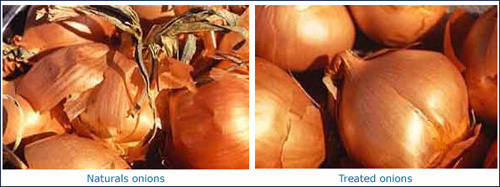Conservation and preservation of food
The effects of radiation on the cells of living or vegetable matter are used to the preservation of certain foods of which they destroy microorganisms and parasites
The action of gamma rays, emitted for instance by a cobalt-60 source, leads to ruptures of chemical bonds in their interaction with the matter of living organisms. This phenomenon allow an efficient and reliable elimination of bacteria, fungi and parasites in food. Such treatments are particularly efficient since the penetrating power of gamma rays ensures that all points of the product are actually processed.

Sprout inhibition of onions
Low-dose irradiation with cobalt-60 (40 to 100 Gy) effectively controls the germination of bulbs such as onions. Onions treated (right) don’t show any sign of germination like their non treated counterparts (left).
© CEA
The effects are dose dependent. The doses used for preservation and sterilization are adapted to their purpose. The scale of these doses is of course not the same as those applied to humans. For example, we take as low a dose of 50 to 100 grays (Gy), whereas such a dose is considered high in the case of radiotherapy of a cancer tumor and would be lethal if applied non-locally to the whole body..
The low dose irradiation inhibits germination, contributes to deworming of grain and fruit and slows down physiological processes of decomposition. Potatoes, onions, shallots are irradiated to inhibit germination so they are conserved longer. Strawberries and tomatoes get the same treatment to slow their maturation. Spices and dried vegetables are also treated to destroy microorganisms. In Japan, sake treated with radiation is apparently appreciated.
At mean dose, we obtain an extension in time of food preservation by irradiation at medium dose and at higher dose industrial sterilization of meat, spices, and foods prepared by irradiation.
Rays leave no radioactive residues in the product. If they disrupt atoms and molecules, they do not attack the nucleus. Radiation is just energy that passes through food, destroying bacteria and other microorganisms, and then dissipates. The only residue is a small amount of molecules that have been affected in the food by the passage of energy.
These radiolysis products, tested by the Food and Drug Administration (FDA) in the U.S., were found the same or similar to those produced by other methods of preservation such as freezing, cooking, adding preservatives. Anyway, there is no preservation process that leaves no trace.
An advantage of irradiation is to leave no chemical additives in food. Its handicap is primarily commercial, the association of food and radioactivity disturbing the consumer uninformed. In France, the number of permits is about thirty.
Other articles on the subject « Applications of Radioactivity »
Inspection and controls
A tool for testing and tune-ups The penetrating property of radiations is commonly used to check [...]
Material Developmnent
Improvements in the quality of industrial products Every day we make use of products that have be[...]
Non Destructive Testing
Control of industrial processes and materials Tracers and radioactive sources are frequently used[...]
Food processing
Eradicate bacteria, fungi and pests with radiation … Gamma rays are used industrially to en[...]
Conservation Effects
A conservation process without additives, non radioactive The biological effects of strong doses [...]
Medfly Eradication
The curse of the medfly and its eradication The Mediterranean flies or Medflies are a dreadful cu[...]
Disinfecting Effects
Getting rid of parasites and germs….. The radiobiological action of radiation leads to damage to [...]
Radioactive Gauges
Instruments for industrial process control In order to be peforming and efficient; modern industr[...]
Sources in Industry
A wide variety of applications Most radioelements in radioactive sources are extracted from small[...]
Various Applications
Because of the fears it inspires, radioactivity is considered in the collective unconscious as ho[...]